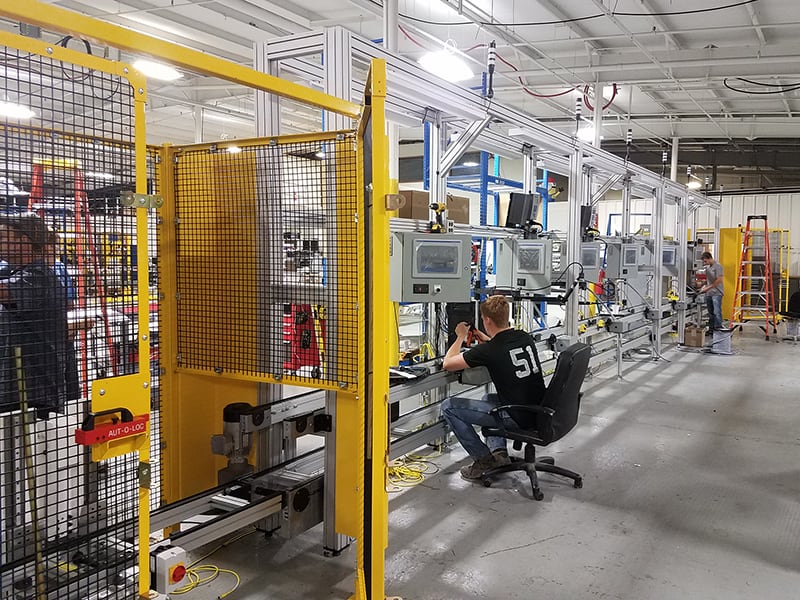Automotive Projects
Since the introduction of the assembly line, automotive manufacturers have looked for innovative ways to assemble parts, inspect and test parts, remove the human element from material handling, and better ways to dispense sealants. Our automation projects are flexible and range from semi-automated solutions to complete integration of robotics and vision tools into the manufacturing process. If you’re looking to save time, increase capacity, and reduce repetitive stress on your employees, Alliance Automation can help evolve your current processes.
Auto Load Trimmer and Assembly
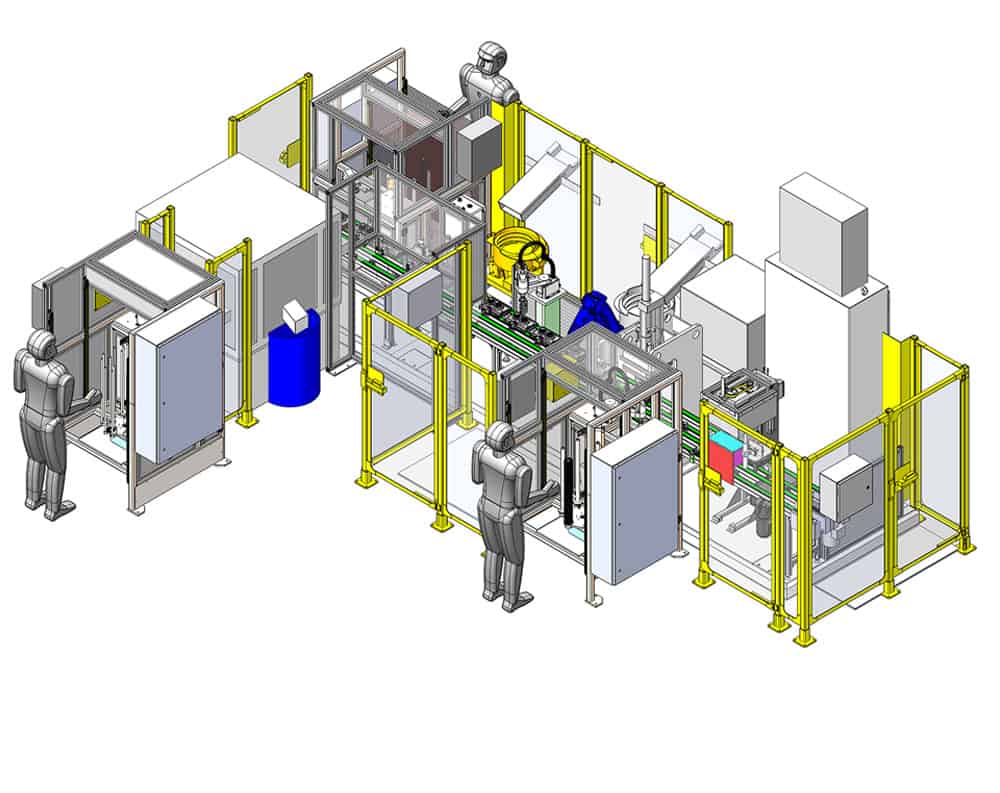
Key Functions
1 Seal every 6 seconds
Operator loaded every 10 minutes
4 mandrels (ea. Holds 50 seals) each loaded at a time
Minimum speed of 10 parts per minute
Leak test system to record pressure decay
Spring test sensor checked for 360-degree spring presence
J-metal is inserted into seal
Press designed to curl with a single stroke
Lubricant spray system
Julian date code ink-jetted onto black rubber with white ink
Seals unloaded onto mandrel turntable
Components
8 mandrel indexing loading system, 4 mandrels loaded at a time
RA Style Auto-Trimmer
Bosch TSPlus Palletized Conveyor System
3 presence checking sensors
Bowl Feeder
Custom escapements and slide plates
(2) Motoman MH5M 6-axis robot
(2) Gripper end of arm tooling with weight sensors (pre & post lubrication)
Cincinnati Sentinel 1-24 leak test system, pressure decay
Spring test system
(2) Grease mandrels with pump
Curling station with forming tool
Cognex vision inspection
Gleitmo 985 Applicator
Hot air blown drying exit conveyor
Domino Ink Jet System
Epson SCARA robot G3-351
6 Unload Mandrels turntable
The Project
This assembly cell used a combination of robots and automation to move a seal through 9 stations that test, visually inspect, lubricate, dry and mark each part. The automation increased throughput removed repetitive tasks, reallocated operators, and improved quality. Grippers used in this process were embedded with weight sensors to ensure lubricant was applied properly thus reducing costs of over application. Seals were properly cured to exact specifications and each seal was marked allowing for traceability. The updated seal loading/unloading process allowed for a single operator to manage the entire process.
Assembly Line
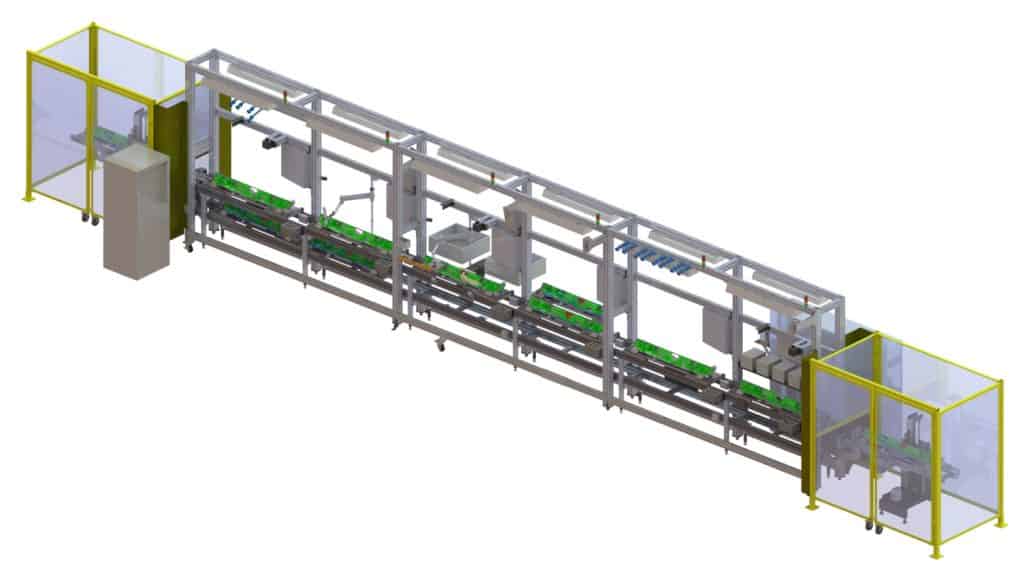
Key Functions
1 Assembly part type with multiple colors
13 parts to be assembled
Line cycle time is 50 seconds
Conveyor length is 61’
Each operation has 80” of conveyor length
Product recipe management
Production line scheduling
Product build history database
Torque and angle feedback for each screw
CHMSL testing
Back-up camera testing
Poke Yoke verification test
2D barcode and QR code of information to be printed.
Components
Bosch Rexroth Over/Under 13 Pallet Conveyor System
Custom part pallet fixtures
Pallet home position sensors
Pneumatic cushioned hard stops
(7) Operation Stations
Opto touch button releases
(2) Vertical Transfer Units
Integrated computer system
(3) Bar Code Scanning and Printing
Error detection sensors
55” Samsung LCD Monitors
(3) Ingersoll Rand Screw Drive System
(3) Pneumatic Air Supply Line
Wireless hand held bar code scanners
Sensors to detect isolator strips
Keyence Vision Camera
Vision Lighting
Wire Harness test connector
Pick and Place part onto conveyor and into trimmer fixture
Electrical Junction Boxes
SMC Remote Input/Output Units
Color Stack Lights with audio alarm
Balluff RFID Read/Write Tags
Five hole button box
Emergency Stops
Reset & reset button
3 Part totes
The Project
The assembly line had to meet ergonomic designs, provide audible sounds and visual indicators for each step and be remotely accessible for future support by Alliance Automation. Quality assurance requirements were achieved by having an operator select a part number from a list, the part is scanned and verified at each station to confirm sonically welded and components are verified. This system checks for proper paint colors, wire harness testing, CHMSL testing, and lot codes allow for traceability recording.
Axle Shaft Assembly
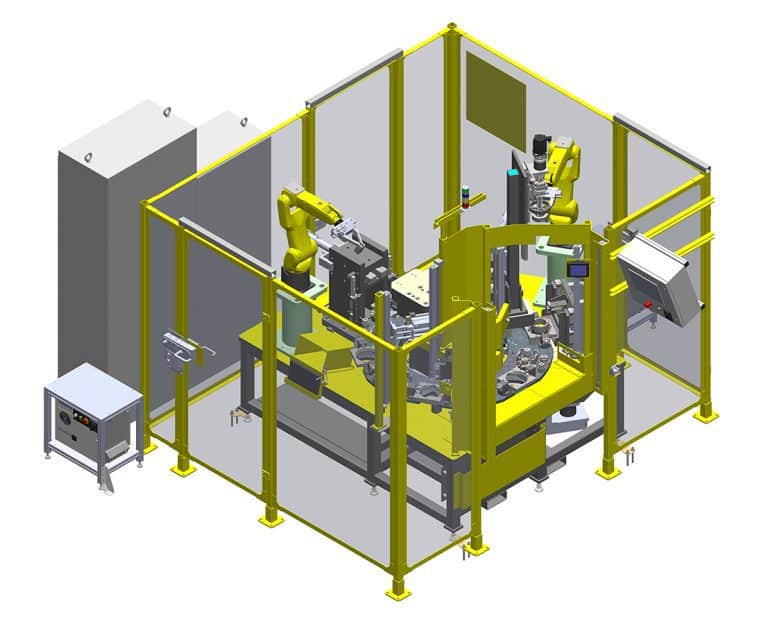
Key Functions
Components
The Project
A consistent part-to-part cycle time was required to increase the production of axles for a high profile customer that required a higher production capacity. By working with Alliance Automation on this project, not only was the customer able to meet their goal of increased production capacity, but this one machine is able to run three different part types. Each axle produced on this assembly machine will ensure the quality standards of each part produced is meet and communicate to the company’s manufacturing execution system.
Cover Sash De-gate & Clip Installation
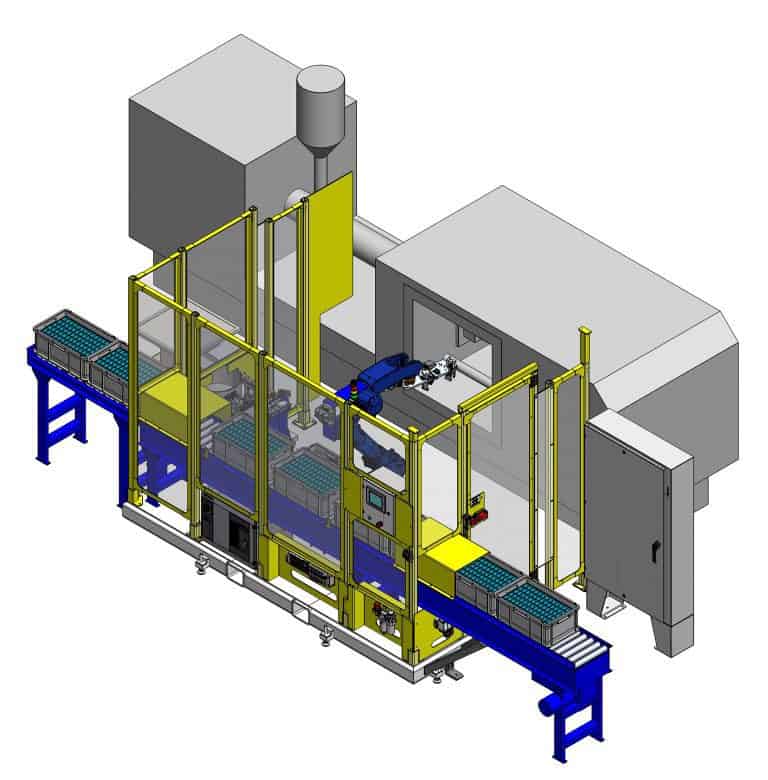
Key Functions
The Project
Dial Table Lamp Assembly
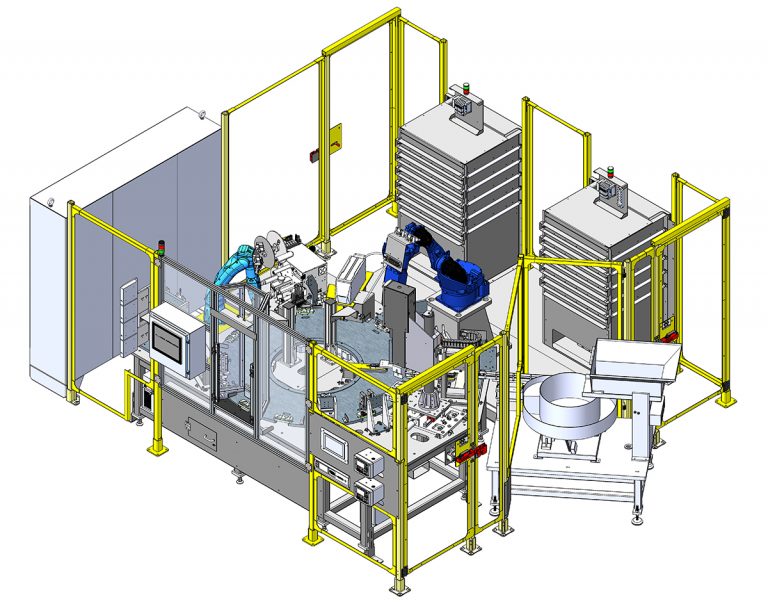
Key Functions
Components

The Project
Dial tables, also known as rotary indexing tables or turntables, are a common automation component used here at Alliance Automation. As opposed to using a longer assembly line process, the rotating circular table design maximizes space and streamlines performance. Assembly, inspection, testing, packaging, and material handling are all key processes employed by our dial tables. The number of indexing positions, rotational speed, and the size of the dial table can vary depending on specific manufacturing application needed. They are valuable tools for achieving high-speed and repeatable manufacturing processes in various industries.
Headliner
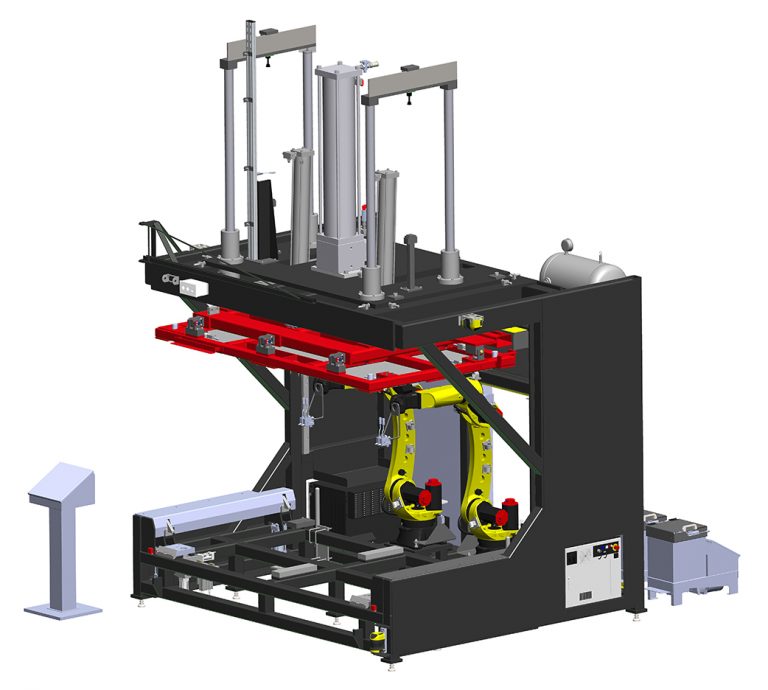
The Project
This turn-key bracket press system reduces overall capital expense by accommodating many different programs with the same CAPEX equipment. Individual fixture-cassettes for each program allow SR, NR, & PR headliners to be built for many different OEMS and programs. The equipment allows fast, safe, & ergonomic high-precision component placement. The fixture-cassette is available in a quick-change configuration, is easy to changeover, and
reduces equipment footprint.
Hydro Mount Assembly System

Components
The Project
This turn-key bracket press system reduces overall capital expense by accommodating many different programs with the same CAPEX equipment. Individual fixture-cassettes for each program allow SR, NR, & PR headliners to be built for many different OEMS and programs. The equipment allows fast, safe, & ergonomic high-precision component placement. The fixture-cassette is available in a quick-change configuration, is easy to changeover, and
reduces equipment footprint.
Lamp Assembly, Test Machine, & Packout

Components
Pallet Shuttle System (25 pallets)
Reject Bin with Sensor
Feeder Bowl System
Escapement
Horizontal and Vertical Pneumatic Cylinders
Pneumatic Gripper
Tray Feed System (5 Trays)
Heat Stake Tooling (2)
5 – Yaskawa GP12 6-Axis Robot
5 – Robot Dual End of Arm Tool (EOAT) w/Pneumatic Gripper
Dukane Vibration Weld System
2 – Cincinnati Test Systems C28 – Pressure Decay Tester
Pneumatic Slide Cylinder
Cognex IS7200C – Light test camera
Light test plug
Keyence IV-HG150MA – Camera
Rotary Actuator
Pneumatic Gripper
Part Present Sensors
Gasket Apply Station:
Keyence Vision System
Roll Feeder
Stripper Assembly
2 – Pneumatic Valves
Keyence Laser Marking System
6 – Part Present Sensors
IMF Effector – RFID System
The Project
This cell had to assemble (5) components into (1) Cargo Lamp Assembly every 10 seconds or less. Vibration welding took 30 seconds to complete, so in order to meet the goal of a 10 second machine cycle time, (4) Cargo Lamp Assemblies had to be welded at the same time. Each part was tested at 1.0 psig pressure decay with 12VDC. Light color and intensity met current limits of 164 mA +/- 15% mA. Production data was retrieved from the PLC through the HMI. This included recording date code or fail code being laser etched to the housing for traceability. Scrap and system failure rate had to be 1%, this meant removing the human element from the assembly process. A cabinet tray feed system was developed to allow the operator to load and unload the parts outside of the work area, allowing the robot to continue picking parts from another tray in the work area.
Lighting & Electronics Assembly
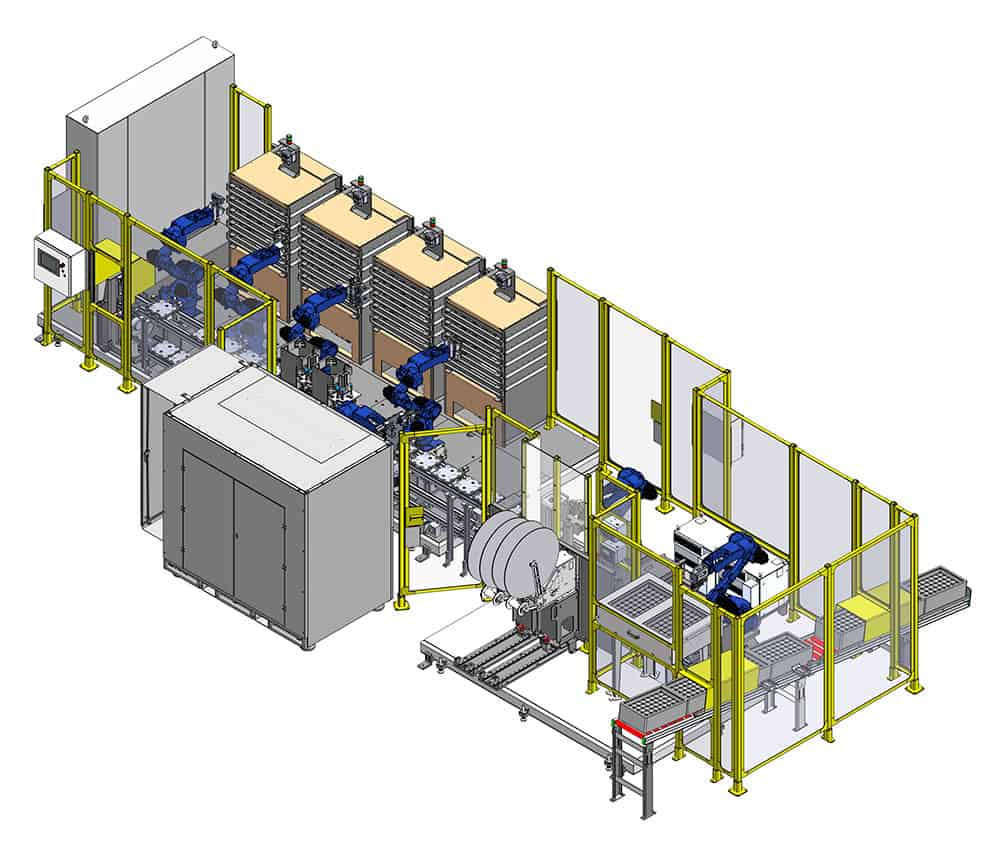
Components
(7) Yaskawa GP12 Six-Axis Robot and Controller
(4) 2-Up End of Arm Tool, profiled nest, pneumatic gripper cylinders, pneumatic actuators
(3) EOAT, (4) part, w/ Pneumatic Gripper
(4) Tray Feeder, 5 drawers ((2) 36 parts, 21 minutes of parts, (1) 144 parts per drawer, 84 minutes of parts, (1) 55 parts per drawer, 32 minutes of parts)
(2) Heat Stake Systems with (12) Extol NanoSTAKE Modules
(21) Heat stake mount tooling with pneumatic up/down actuation
(4) Part present sensor
(1) Dukane – Vibration Weld System with (4) parts welded during one cycle
(2) Cincinnati Test Systems C28 – Pressure Decay Tester
(2) Seal Test Tooling – Quick Change
(3) Keyence vision camera
(2) Cognex IC7802C camera
(2) Accuplace label units with roll feeder, stripper assembly & 2-Part Gasket Nest
(1) Keyence MDX2020A, 3-Axis Hybrid Laser Marker
(13) RFID Read Heads & Lift and locate units
(29) Base pallet with RFID pallet tag
The Project
This fully automated system uses 5 tray feeding systems to introduce parts to robots to place the parts into pallet nests. Robots place PCBA and light guides into part housings where they are heat staked, the part is then presented to the vibration weld process and then enter the leak test station. The parts will proceed through the light and electric test, pin checked, and then have the gasket installed and checked. Each part is laser marked and will then be packed out one at a time into a tote on a gravity conveyor.
Stabilizer Bushing Laser Cutter
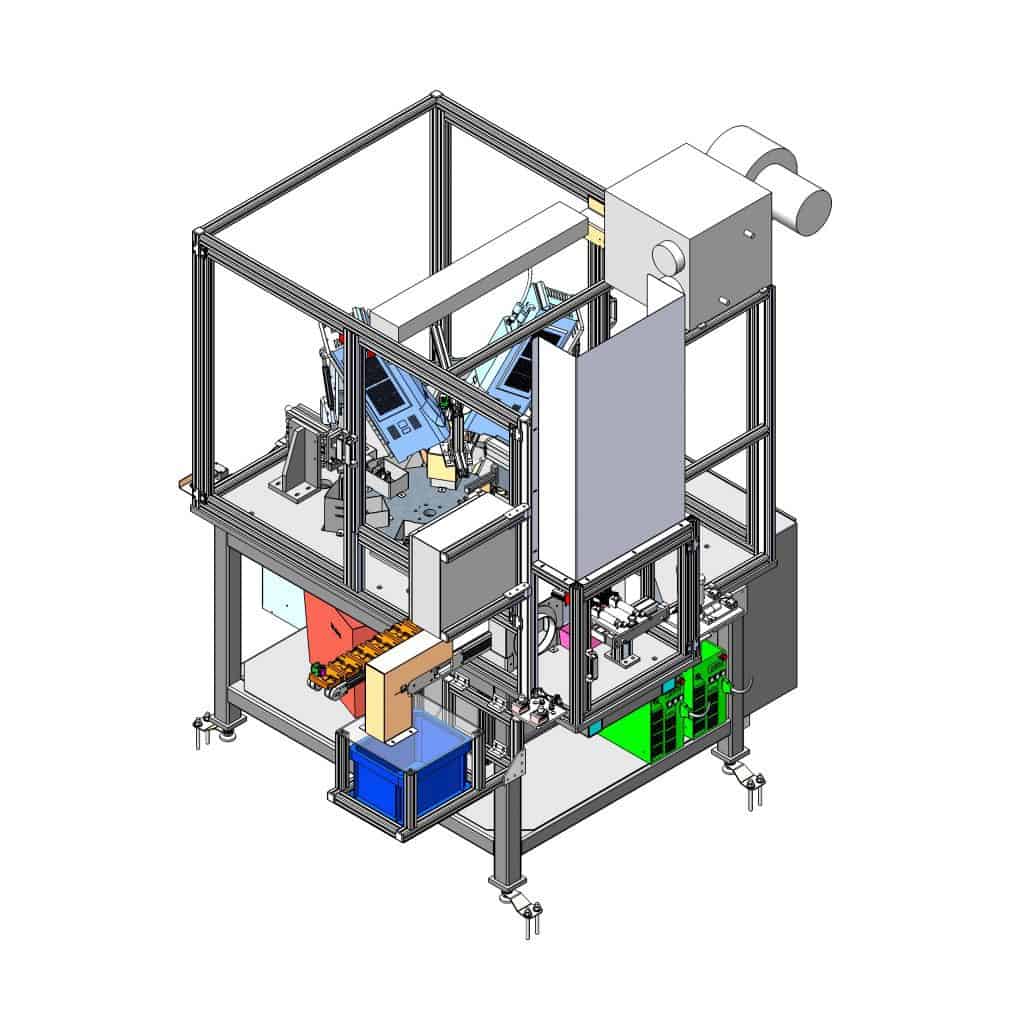
The Project
This machine is utilized to trim rubber/fabric stabilizer bushings for an automotive customer via a laser. Benefits of this system include multiple SKU’s, increased efficiency and safety, and quick-change tooling which allows for easy change-overs throughout the production day.
Stand-Alone TPMS Snap-In
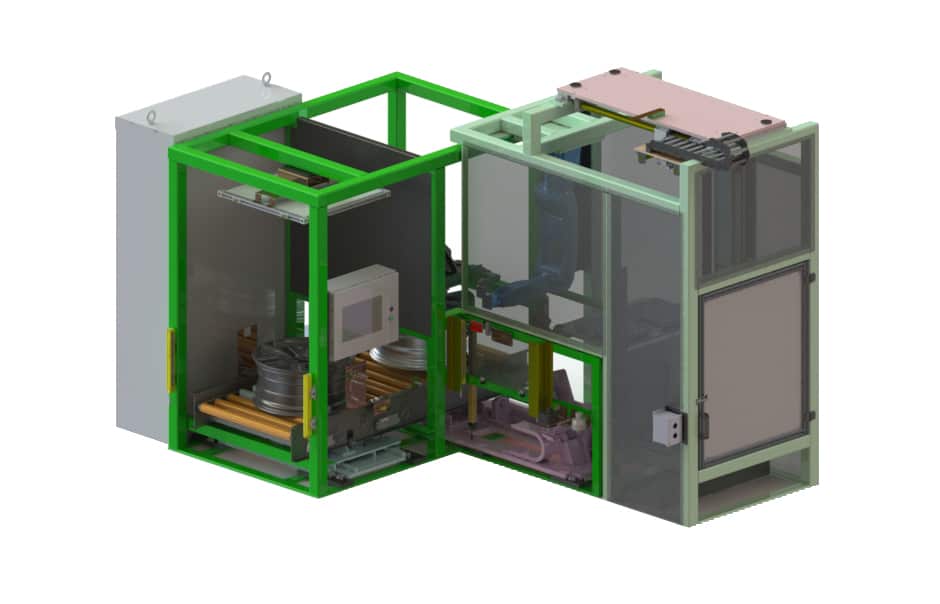
Key Functions
Two-station system automatically sizes wheel, locates the wheel’s valve hole, and snaps-in a TPMS valve-stem.
System works with 5 different part sizes, designed to add additional parts.
Vision system identifies wheel by spoke pattern & diameter then compares to system recipe.
Wheel pass through if model does not require a valve.
Operator alerted of any failures.
Part to part cycle time is 10.5 seconds.
Maintains insertion angle of +/- 10◦
Horizontal angle maintained by +/- 1◦
Max force: 600-1100N
Max insertion rate 100-500 mm/min
No forces applied to back side of TPMS Sensor
The Project
This stand-alone TPMS snap-in machine was built to remove repetitive processes by operators, maintain production rates, and to ensure the proper seating of the valve stem. The system had to be able to size the height and width of each wheel, elevate the wheel from the transfer conveyor, rotate the wheel, locate the valve hole, and position the wheel such that the valve hole is presented to the TPMS snap-in device. The snap-in device had to retract to allow an operator to place a TPMS valve-stem into the device’s part holder, the operator triggers the system and the device returns to the line and snaps the stem fully into the wheel.
Strut Mount Assembly

The Project
This assembly cell was designed and built by Alliance Automation to assembly an automotive strut mount. The operator will load the components into nests on a rotary dial. The dial rotates and a 6-axis robot moves the components to a pressing application. The components are returned to the dial and rotated into another press application. Another robot then picks the assembled component and loads into a finished goods tote. The operator then unloads the full tote and loads empty totes onto the conveyors.
Automotive Automation Opportunity Areas:
- High Speed Assembly
- Quality Inspection
- Palletizing
- Packaging/Shipping
- Testing
- Material Handling
- Glass Application
- Press Automation
- Powertrain
- Sealer, Paint, and Dispensing Applications
- Assembly Solutions; Part & Body Assembly
- Tire & Wheel Systems
- Fiber Processing
- Inspection & Testing
- Laser Application
- Material Handling solutions
- Metal processing
- Micro precision applications
- Plastics Processing
- Robotics Integration
- Software & Data
- Integration
- Vision Applications
Companies need a partner they can trust to install robotics, vision, laser inspection, sensors, and part testing into their production lines. Whether it is a fully automated line or specific tasks, automated equipment is ideal for completing repetitive tasks like moving parts across stations, applying sealants, and joining materials.
Who We’ve Worked with in the Automotive Industry

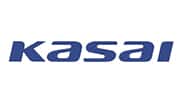



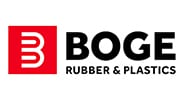
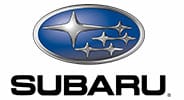

Is Automotive Automation Right for your Business?
-
Is your current manufacturing process struggling to meet quality standards?
-
Do you have a new product or change to a product that you need to add to your production process?
-
Is it time for your company to bid for new business opportunities and gain assistance?
-
Have you struggled with labor requirements for production?
-
Are your current customers requesting new functions or testing to be integrated into production?
Why you should Join the Alliance
When you partner with Alliance Automation you're getting more than just a robotic solution.
Alliance Automation is here to design, build and install a custom solution to fit your exact needs. Our products will solve your business challenges. How? We follow the Alliance Proven Process. Alliance Automation doesn’t just sell you a product; we get to know your business and find solutions to help you reach your goals.
What we offer:
- Project Review
- Risk Analysis and Risk Assessments
- Budgetary and complete project proposals
- CAD Designers
- Fabrication
- Toolmakers
- Machinists
- Mechanical Engineers
- Electrical Engineers
- Controls Engineers
- Project Managers
- Full Implementation teams

